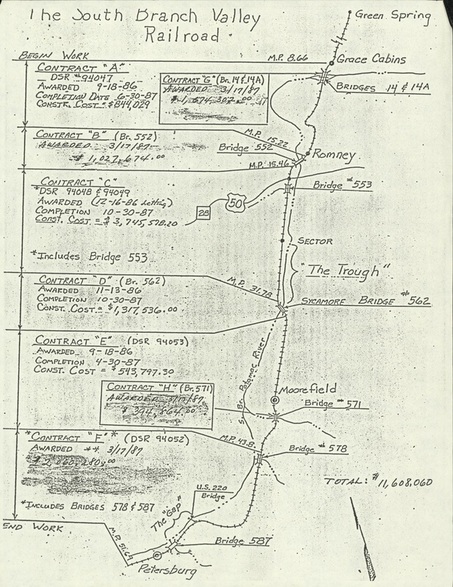|
By Jody Brumage Beginning in the mid-1970s, Senator Byrd was actively involved with aiding the West Virginia State Rail Authority in saving a short-line railroad located in the eastern part of the state. The South Branch Valley Railroad begins in the City of Petersburg in Grant County, West Virginia, and runs fifty-two miles north through Hardy and Hampshire Counties to Green Spring, where it crosses the Potomac River and connects to the old Baltimore and Ohio (B&O) main line (now owned and operated by CSX). Originally built by the South Branch Railroad Company in 1884, the line was purchased in the early 20th century by the B&O. In 1976, after decades of deterioration due to neglect, the B&O sought Interstate Commerce Commission (ICC) approval to abandon the line. Within two years, owing to the work of Senator Robert C. Byrd and Congressman Harley O. Staggers, Sr. in arranging a transfer of the line, the State of West Virginia took ownership of the South Branch Valley Line. West Virginia became the first state in the country to own and operate a commercial railroad. Between 1981 and 1984, Senator Byrd obtained $5 million in various appropriations bills to help the West Virginia State Rail Authority restore the South Branch Valley Line’s bridges and tracks. By 1985, work had been completed and the line was fully operational. However, disaster struck in the fall of that year when a major flood, one of the worst in the state’s history, wiped out large sections of the rail line. Amid calls for abandoning the project, Senator Byrd worked with the Federal Emergency Management Agency(FEMA) to obtain $12 million to rebuild the line. This money came as part of a $250 million emergency appropriation to FEMA for overseeing the rebuilding of flood-ravaged areas throughout the state. Two years later, in December of 1987, the line was once again active.
A major impetus for restoring service to the line was the tourism opportunity it presented in addition to freight service. On the border between Hardy and Hampshire Counties, the South Branch Valley line travels through a narrow valley called “the Trough” where bald eagles nest. Today, the Potomac Eagle Scenic Railroad offers roundtrips on the South Branch Valley line through the area, providing a major economic boost to local businesses. Through his support for rebuilding the South Branch Valley Railroad, Senator Byrd helped establish a successful economic model and rationale for saving short-line railroads in the nation which many major rail lines were abandoning during the industry’s financial hardships. Staff memos and reports indicate that the project to keep the South Branch Valley Railroad in business saved upwards of 2,000 jobs in the region and supported several local industries that relied upon the freight service offered by the line. The West Virginia State Rail Authority continues to operate the South Branch Valley Railroad in addition to two other rail lines, seven “rail trails,” and the historic Cass Scenic Railroad in Pocahontas County. In addition to the economic benefits they provide for their regions, these railroads are historic assets for the State of West Virginia. The documents and map featured in this blog are from the WV Project Series of the Robert C. Byrd Congressional Papers. Comments are closed.
|
Welcome to the Byrd Center Blog! We share content here including research from our archival collections, articles from our director, and information on upcoming events.
Categories
All
Archives
July 2023
|
Our Mission: |
The Byrd Center advances representative democracy by promoting a better understanding of the United States Congress and the Constitution through programs and research that engage citizens.
|
Copyright © Robert C. Byrd Center for Congressional History and Education
|


 RSS Feed
RSS Feed
